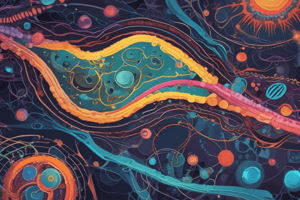Podcast
Questions and Answers
What is transcription?
What is transcription?
Transcription is the process of transferring genetic information from DNA to RNA.
What are the main phases of transcription?
What are the main phases of transcription?
- Template Binding & Formation of Preinitiation Complex (PIC) (correct)
- Elongation (correct)
- Initiation (correct)
- Termination (correct)
During transcription, the RNA polymerase moves in the 3' to 5' direction along the DNA template.
During transcription, the RNA polymerase moves in the 3' to 5' direction along the DNA template.
False (B)
The sequence of RNA is complementary to the sequence of the template strand, and it is the same as that of the coding strand except for _ replacing T.
The sequence of RNA is complementary to the sequence of the template strand, and it is the same as that of the coding strand except for _ replacing T.
Match the following terms with their definitions:
Match the following terms with their definitions:
Which proteins bind to the CAAT box and GC box during transcription?
Which proteins bind to the CAAT box and GC box during transcription?
Which transcription factor binds specifically to the TATA box promoter element?
Which transcription factor binds specifically to the TATA box promoter element?
TFIIH has kinase activity that activates RNAP by phosphorylation.
TFIIH has kinase activity that activates RNAP by phosphorylation.
During transcription, the RNA polymerase utilizes ribonucleoside triphosphates (ATP, GTP, CTP, and UTP), and releases ______ each time a nucleotide is added to the growing chain.
During transcription, the RNA polymerase utilizes ribonucleoside triphosphates (ATP, GTP, CTP, and UTP), and releases ______ each time a nucleotide is added to the growing chain.
Match the following transcription steps with their descriptions:
Match the following transcription steps with their descriptions:
Flashcards are hidden until you start studying
Study Notes
Transcription
- RNA synthesis is the transfer of information from DNA to RNA, a template-directed process that takes place in 5' to 3' direction by polymerization of nucleoside triphosphates (NTP).
- The basic mechanism of RNA synthesis is the same for all types of RNAs: messenger (mRNAs), ribosomal (rRNAs), and transfer (tRNAs).
- RNA synthesis is catalyzed by a group of enzymes termed RNA polymerases (RNAP).
Principles of Transcription and Terminology
- Only one strand of DNA is transcribed, known as the Template strand, while the other strand is known as the Coding strand.
- The sequence of RNA is complementary to the sequence of the template strand, and it is the same as that of the coding strand except for U replacing T.
- Upstream: In the 3’ direction of the template strand.
- Downstream: In the 5’ direction of the template strand.
- Transcription region: The nucleotide sequence transcribed by RNAP.
- Promoter: A nucleotide sequence in the template strand at which the RNAP begins attachment.
- Terminator: A nucleotide sequence in the template strand that lies downstream the transcription unit and marks its end.
- Start Point: The nucleotide at the 3’ end of the transcription region.
- Transcription unit includes: The Promoter, Transcription Region, and the Terminator.
Phases of Transcription
- Template Binding & Formation of Preinitiation Complex (PIC): The binding of RNA polymerase (RNAP) to a region on the DNA of the template strand which is specific and is known as the promoter region.
- Initiation: After the promoter region is recognized by the RNA polymerase, it moves along the template strand towards the +1 nucleotide and starts to synthesize a complementary transcript of the template DNA strand in the 5’ to 3’ direction.
- Elongation: The process of elongation of the RNA chain continues until a termination signal is reached.
- Termination: When a termination signal is reached, termination occurs.
Transcription in Prokaryotes
- Prokaryotic RNA polymerase consists of a core enzyme and a sigma factor (s subunit).
- The core enzyme is formed of five subunits: 1w, 2a, 1ß, and 1ß’, responsible for the 5’ to 3’ RNA polymerase activity.
- The sigma factor enables RNA polymerase to recognize the specific promoter regions on the DNA.
- The prokaryotic promoter contains two characteristic consensus sequences: -10 element and – 35 element.
- The -10 element is formed of 6 nucleotides (5'-TATAAT-3') centered about ten nucleotides to the left of the transcription start site.
- The -35 element is a second consensus sequence (5'-TTGACA-3'), centered about 35 bases to the left of the transcription start site.
Transcription in Eukaryotes
- Eukaryotic cells contain 3 Nuclear and 1 Mitochondrial RNAP.
- Mitochondrial RNAP: Transcribes all mitochondrial genes.
- Nuclear RNA polymerases are designated by Roman Numbers I, II, and III.
- RNA polymerase I: for the synthesis of 45S RNA, which is cleaved to release the mature 18S, 5.8S, and 28S rRNA.
- RNA polymerase II: for the synthesis of mRNAs, most small nuclear RNAs (snRNAs) and microRNAs (miRNAs).
- RNA polymerase III: for synthesis of tRNAs, 5S rRNA and one snRNA.
Eukaryotic Promoter
- Two types of sequence elements are present in the eukaryotic promoter: TATA Box and CAAT box regions.
- TATA Box (Hogness Box): defines where transcription is to commence along the DNA.
- CAAT box and GC box regions: determine the Frequency of Transcription.
Steps of Transcription in Eukaryotes
- Template Binding & Formation of Preinitiation Complex (PIC): requires, in addition to RNA pol II, the general transcription factors (GTFs): TFIIA, TFIIB, TFIID, TFIIE, TFIIF, and TFIIH.
- Initiation: TFIIH has a kinase activity that activates RNAP by its phosphorylation and a helicase activity that separates the two strands of DNA for initiation.
- Elongation: The RNA polymerase utilizes ribonucleoside triphosphates (ATP, GTP, CTP, and UTP), and releases pyrophosphate each time a nucleotide is added to the growing chain.
- Termination: RNAP II ends transcription when it reaches a termination signal.
Studying That Suits You
Use AI to generate personalized quizzes and flashcards to suit your learning preferences.



![Transcription in Prokaryotes: RNA Polymerase [Part 1]](https://assets.quizgecko.com/cdn-cgi/image/width=300,height=200,fit=crop,quality=75,format=webp/quiz/baed4520f1a7fc99e7641e1e05a42c62.jpg)